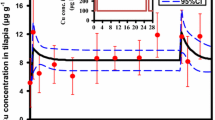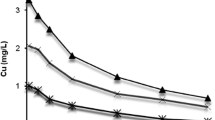Abstract
One of the major challenges in assessing the potential metal stress to aquatic organisms is explicitly predicting the internal dose in target organs. We aimed to understand the main sources of copper (Cu) accumulation in target organs of tilapia (Oreochromis mossambicus) and to investigate how the fish alter the process of Cu uptake, depuration, and accumulation (toxicokinetics (TK)) under prolonged conditions. We measured the temporal Cu profiles in selected organs after single and combined exposure to waterborne and dietary Cu for 14 days. Quantitative relations between different sources and levels of Cu, duration of treatment, and organ-specific Cu concentrations were established using TK modeling approaches. We show that water was the main source of Cu in the gills (>94 %), liver (>89 %), and alimentary canal (>86 %); the major source of Cu in the muscle (>51 %) was food. Cu uptake and depuration in tilapia organs were mediated under prolonged exposure conditions. In general, the uptake rate, depuration rate, and net bioaccumulation ability in all selected organs decreased with increasing waterborne Cu levels and duration of exposure. Muscle played a key role in accounting for the rapid Cu accumulation in the first period after exposure. Conversely, the liver acted as a terminal Cu storage site when exposure was extended. The TK processes of Cu in tilapia were highly changed under higher exposure conditions. The commonly used bioaccumulation model might lead to overestimations of the internal metal concentration with the basic assumption of constant TK processes.



Similar content being viewed by others
References
Adams WJ, DeForest DK, Brix KV. Evaluating copper bioaccumulation in aquatic risk assessments. In: Cobre 2003—Proceedings of the Symposium, Santiago, Dec 2003, pp. 1–11
Carriquiriborde P, Ronco AE (2008) Distinctive accumulation patterns of Cd(II), Cu(II), and Cr(VI) in tissue of the South American teleost, pejerrey (Odontesthes bonariensis). Aquat Toxicol 86:313–322
Cooper S, Hare L, Campbell PGC (2010) Modeling cadmium uptake from water and food by the freshwater bivalve Pyganodon grandis. Can J Fish Aquat Sci 67(11):1874–1888
Dang F, Zhong H, Wang WX (2009) Copper uptake kinetics and regulation in a marine fish after waterborne copper acclimation. Aquat Toxicol 94:238–244
Dang F, Wang WX, Rainbow PS (2012a) Unifying prolonged copper exposure, accumulation, and toxicity from food and water in a marine fish. Environ Sci Technol 46:3465–3471
Dang F, Rainbow P, Wang WX (2012b) Dietary toxicity of field-contaminated invertebrates to marine fish: effects of metal doses and sucellular metal distribution. Aquat Toxicol 120–121:1–10
De Boeck G, Eyckmans M, Lardon I, Bobbaers R, Sinha AK, Blust R (2010) Metal accumulation and metallothionein induction in the spotted dogfish Scyliorhinus canicula. Comp Biochem Physiol A 155:503–508
Environmental Protection Administration, ROC (Taiwan) (2001). Available from http://ivy5.epa.gov.tw/epalaw/index.aspx
Erickson JR, Mount DR, Highland TL, Hockett JR, Leonard EN, Mattson VR, Dawson TD, Lott KG (2010) Effects of copper, cadmium, lead, and arsenic in a live diet on juvenile fish growth. Can J Fish Aquat Sci 67(11):1816–1826
Escher BI, Hermens JLM (2004) Internal exposure: linking bioavailability to effects. Environ Sci Technol 38:455A–462A
Green WW, Mirza RS, Wood CM, Pyle GG (2010) Copper binding dynamics and olfactory impairment in fathead minnows (Pimephale promelas). Environ Sci Technol 44:1431–1437
Grosell M, Boetius I, Hansen HJM, Rosenkilde P (1996) Influence of preexposure to sublethal levels of copper on Cu uptake and distribution among tissues of the European eel (Anguilla anguilla). Comp Biochem Physiol C 114:229–235
Grosell MH, Hogstrand C, Wood CM (1997) Cu uptake and turnover in both Cu acclimated and non-acclimated rainbow trout (Oncorhynchus mykiss). Aquat Toxicol 38:257–276
Higgins CP, Paesani ZJ, Chalew TE, Halden RU (2009) Bioaccumulation of triclocarban in Lumbriculus variegatus. Environ Toxicol Chem 28:2580–2586
Hogstrand C, Grosell M, Wood CM, Hansen H (2003) Internal redistribution of radiolabelled silver among tissues of rainbow trout (Oncorhynchus mykiss) and European eel (Anguilla anguilla): the influence of silver speciation. Aquat Toxicol 63:139–157
Iger Y, Lock RAC, van der Meij JCA, Wendelaar Bonga SE (1994) Effects of water-borne cadmium on the skin of the common carp (Cyprinus carpio). Arch Environ Contam Toxicol 26:342–350
Janssen CR, Heijerick DG, De Schamphelaere KAC, Allen HE (2003) Environmental risk assessment of metals: tools for incorporating bioavailability. Environ Int 28:793–800
Kamunde C, Grosell M, Higgs D, Wood CM (2002a) Copper metabolism in actively growing rainbow trout (Oncorhynchus mykiss) interactions between dietary and waterborne copper uptake. J Exp Biol 205:279–290
Kamunde C, Clayton C, Wood CM (2002b) Waterborne vs. dietary copper uptake in rainbow trout and the effects of previous waterborne copper exposure. Am J Physiol Regul Integr Comp Physiol 283:R69–R78
Kraemer LD, Campbell PGC, Hare L (2005) A field study examining metal elimination kinetics in juvenile yellow perch (Perca flavescens). Aquat Toxicol 75:108–126
Kraemer LD, Campbell PGC, Hare L (2008) Modeling cadmium accumulation in indigenous yellow perch (Perca flavescens). Can J Fish Aquat Sci 65:1623–1634
Luoma SN, Rainbow PS (2005) Why is metal bioaccumulation so variable? Biodynamics as a unifying concept. Environ Sci Technol 39:1921–1931
McGeer J, Brix KV, Skeaff JM, DeForest DK, Brigham SI, Adams B, Green A (2003) Inverse relationship between bioconcentration factor and exposure concentration for metals: implications for hazard assessment of metals in the aquatic environment. Environ Toxicol Chem 22:1017–1037
Muscatello JR, Liber K (2010) Uranium uptake and depuration in the aquatic invertebrate Chironomus tentans. Environ Pollut 158:1696–1701
Newman MC, Unger MA (2003) Fundamentals of ecotoxicology, second ed. Lewis Publishers/CRC Press, Boca Raton
Pelgrom SMGJ, Lock RAC, Balm PHM, Wendelaar Bonga SE (1995) Integrated physiological response of tilapia, Oreochromis mossambicus, to sublethal copper exposure. Aquat Toxicol 32:303–320
Rainbow PS (2002) Trace metal concentrations in aquatic invertebrates: why or so what? Environ Pollut 120:497–507
Tsai JW, Chen WY, Ju YR, Liao CM (2009) Bioavailability links mode of action can improve the long-term field risk assessment for tilapia exposed to arsenic. Environ Int 35:727–736
Wallace WG, Lopez GR, Levinton JS (1998) Cadmium resistance in an oligochaete and its effect on cadmium trophic transfer to an omnivorous shrimp. Mar Ecol Prog Ser 172:225–237
Wu SM, Ding HR, Lin LY, Lin YS (2008) Juvenile tilapia (Oreochromis mossambicus) strive to maintain physiological functions after waterborne copper exposure. Arch Environ Contam Toxicol 54(3):482–492
Acknowledgments
We thank W.S. Ma and C.J. Huang for assistance with equipment maintenance and data analysis. This research was financially supported by the Taiwan National Science Council (NSC 99-2313-B-039-004-MY3) and China Medical University (CMU98-N1-15).
Author information
Authors and Affiliations
Corresponding author
Additional information
Responsible editor: Henner Hollert
Rights and permissions
About this article
Cite this article
Tsai, JW., Ju, YR., Huang, YH. et al. Toxicokinetics of tilapia following high exposure to waterborne and dietary copper and implications for coping mechanisms. Environ Sci Pollut Res 20, 3771–3780 (2013). https://doi.org/10.1007/s11356-012-1304-3
Received:
Accepted:
Published:
Issue Date:
DOI: https://doi.org/10.1007/s11356-012-1304-3




